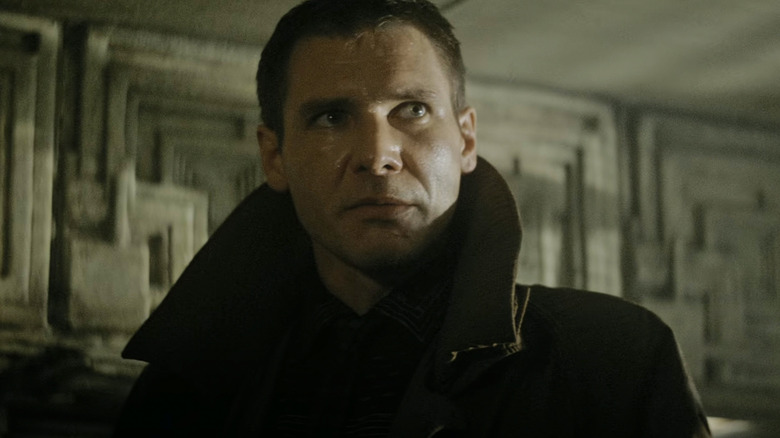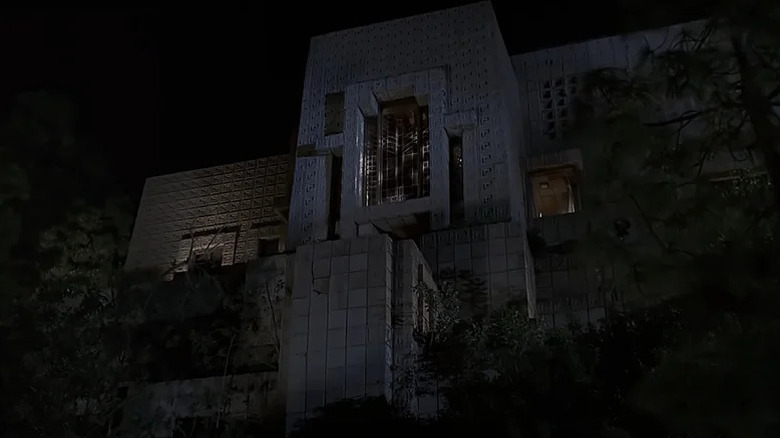One Los Angeles Mansion Played Host To Both Buffy The Vampire Slayer And Blade Runner
The picturesque hills of the Los Angeles neighborhood, Los Feliz, might not seem like the kind of place you'd find an icon of horror and sci-fi cinema, but that's exactly what sits at 2607 Glendower Avenue.
There's plenty of Hollywood history in Los Feliz, which is also home to the most famous movie high school in America. But Frank Lloyd Wright's Ennis House is surely one of the most striking sites in the neighborhood, which borders Griffith Park and is overlooked by the LA tourist spot where the Terminator became a sci-fi icon. The Ennis House is one of Wright's most celebrated architectural achievements and has, according to the Frank Lloyd Wright Foundation, been used throughout cinema history as a location for more than 80 productions.
As such, even if you've never even heard of the Ennis House, chances are you've seen it before. In fact, if you happen to be a "Blade Runner" or "Buffy the Vampire Slayer" fan, you're very familiar with the grandiose home.
The Ennis House was made famous by classic horror
The Ennis House was the last of four "textile block" houses created by Frank Lloyd Wright, who crafted the unique aesthetic using 27,000 blocks made of gravel, granite, and sand. These blocks were created in aluminum molds that included a unique interlocking pattern, giving each block, and by extension, the house as a whole, a pronounced texture. The result is a structure that feels at once ancient and futuristic, its Mayan Revival architecture atop the Los Feliz hills evoking an almost otherworldly feel.
Completed in 1924, the house was originally designed for retailer Charles Ennis, with Wright writing in a letter to Mr. and Mrs. Ennis, "You see, the final result is going to stand on that hill a hundred years or more. Long after we are gone, it will be pointed out as the Ennis House, and pilgrimages will be made to it by lovers of the beautiful — from everywhere." The impressive home certainly attracted attention, most of it from Hollywood studios, which have turned the structure into a star in its own right.
The first time the Ennis House played a major part in a film was in William Castle's 1959 horror "The House on Haunted Hill," (which received a 90s remake that stands as one of the worst horror movies of the decade) in which Vincent Price's millionaire Frederick Loren brings five guests to his home for the night and offers them a cash prize if they survive. Exterior shots of the Ennis House were used for the titular manse, but the interiors were mostly shot on soundstages. Similarly, in the early '80s, Ridley Scott used the exterior of Wright's house for his seminal sci-fi outing "Blade Runner." In the movie, the Ennis House stands in for Rick Deckard's (Harrison Ford) apartment, but its influence on the film went beyond a quick exterior shot.
The Ennis House was featured in Buffy and Blade Runner
In "Blade Runner," the Ennis House facade and motor court can be seen as Rick Deckard drives into his apartment building. But production designers for the film wanted to extend the architectural style of the home into their set designs, creating foam molds of the blocks used on the Ennis House and fabricating new fake blocks which were then used to decorate the interior sets of Deckard's apartment.
This approach was echoed years later when Ennis House was used as a filming location for "Buffy the Vampire Slayer." The home stood in for the exterior of Spike (James Marsters) and his wife Drusilla's (Juliet Landau) mansion. Spike was the "big bad" of "Buffy" season 2, and his decrepit mansion in the hills of Sunnydale, known as the Crawford Street mansion, was his base of operations. In season 3, that same mansion hosted David Boreanaz's Angel, and while the only real shots of the Ennis House used in the show were of the facade, that facade influenced the design of the interior. Created on soundstages, the mansion interiors were constructed using a similar "textile block" aesthetic to the Ennis House itself, extending the influence of Frank Lloyd Wright's take on the Mayan Revival style even further into screen history.
In its more than 100-year history, the Ennis House has also appeared in "The Day of the Locust," "Mulholland Drive," "Rush Hour," "Beverly Hills Cop II," and numerous other productions. Though it was seriously damaged in the 1994 Northridge earthquake, and took a further beating during the rains of 2005, extensive renovations have taken place in the years since, hopefully ensuring the home remains standing for another 100 years.


